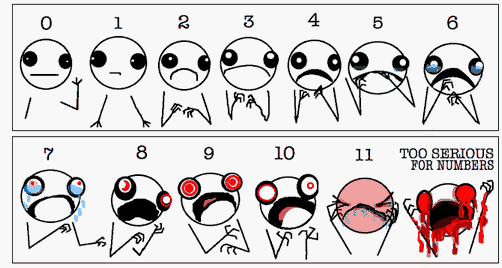
Mosby Pain Scale
Pain Scales are notorious for inadequately addressing pain. Presented here is the simple, and most common, pain scale appearing in many doctor's offices.
 Mosby Pain Scale |
Notable and prolific blogger, Allie Brosh *, humorously points out the shortcomings of the above scale with her own interpretation of the chart:
0: Haha! I'm not wearing any pants!
2: Awesome! Someone just offered me a free hot dog!
4: Huh. I never knew that about giraffes.
6: I'm sorry about your cat, but can we talk about something else now? I'm bored.
8: The ice cream I bought barely has any cookie dough chunks in it. This is not what I expected and I am disappointed.
10: You hurt my feelings and now I'm crying!
She went on to provide a more useful chart for describing pain (see below):
 Brosh Pain Scale * |
0: Hi. I am not experiencing any pain at all. I don't know why I'm even here.
1: I am completely unsure whether I am experiencing pain or itching, or maybe I just have a bad taste in my mouth.
2: I probably just need a Band Aid.
3: This is distressing. I don't want this to be happening to me at all.
4: My pain is not f---ing around.
5: Why is this happening to me??
6: Ow. Okay, my pain is super legit now.
7: I see Jesus coming for me and I'm scared.
8: I am experiencing a disturbing amount of pain. I might actually be dying. Please help.
9: I am almost definitely dying.
10: I am actively being mauled by a bear.
11: Blood is going to explode out of my face at any moment.
Too Serious For Numbers: I probably have Ebola. It appears that I may also be suffering from Stigmata and/or pinkeye.
No question Brosh's pain scale is both more accurate and more useful than the simple pain scale. The traditional scale is perhaps better suited for measuring mood, as the only thing that changes is the facial expressions. This would imply that pain is entirely superficial and can be discerned primarily by evaluating one's facial expression. What's more, the categories of 0, 2, 4 ... 10 leave much to be desired by way of scaling, as we cannot see what a 1, 3, 5, etc. would look like. This, of course, excludes the fact that the traditional scale somewhat demeans individuals experiencing pain by asking them to accord their experience with a series of smiling and frowning faces.
Brosh's scale, on the other hand, is far more expressive, exhaustive, and better captures the experience of being in pain. Her scale includes multiple facets of pain, including body language, facial expressions, tears, blood, and a host of emotions that better describe the construct of pain. In this representation, the stick figure essentially becomes the embodiment of the pain and the textual description makes each measure much more interpretable, accurate, and relatable to those providing the evaluation. Further, Brosh addresses the many nuances of pain, including the growing intensity, extended duration, and quality. For instance, at 10, she describes pain as not only local and intense, but also as though something is being done to an individual and s/he is helpless to make it stop. In the "Too Serious for Numbers" category the pain is off the charts and is so intense that it extends beyond the physical and appears to happen at a spiritual level as well. Unlike the measures beginning at 7 that insinuate death is a real possibility and something that should be dreaded, the final category almost conveys the notion that if death does not occur one will be disappointed.
While Brosh's piece was originally intended to be humorous, it is astounding that her scale has far more elements of validity and quality measurement than many scientifically accepted scales. This affirms the notion that good measurement does not require sophisticated training in statistics or psychometrics, but rather an acceptance and understanding of the basic requirements for measurement.
Authors:
Kenneth D. Royal, University of North Carolina - Chapel Hill
Allie Brosh, Blogger at hyperboleandahalf.blogspot.com
*To access the original article see: Brosch, A. (2010). Boyfriend Doesn't Have Ebola. Probably. Available at: http://hyperboleandahalf.blogspot.com/2010/02/boyfriend-doesnt-have-ebola-probably.html.
A More Accurate Pain Scale? Kenneth D. Royal & Allie Brosh … Rasch Measurement Transactions, 2013, 26:4 p. 1398
| Forum | Rasch Measurement Forum to discuss any Rasch-related topic |
Go to Top of Page
Go to index of all Rasch Measurement Transactions
AERA members: Join the Rasch Measurement SIG and receive the printed version of RMT
Some back issues of RMT are available as bound volumes
Subscribe to Journal of Applied Measurement
Go to Institute for Objective Measurement Home Page. The Rasch Measurement SIG (AERA) thanks the Institute for Objective Measurement for inviting the publication of Rasch Measurement Transactions on the Institute's website, www.rasch.org.
| Coming Rasch-related Events | |
|---|---|
| Jan. 16 - Feb. 13, 2025, Fri.-Fri. | On-line workshop: Rasch Measurement - Core Topics (E. Smith, Winsteps), www.statistics.com |
| Apr. 8 - Apr. 11, 2026, Wed.-Sat. | National Council for Measurement in Education - Los Angeles, CA, ncme.org/events/2026-annual-meeting |
| Apr. 8 - Apr. 12, 2026, Wed.-Sun. | American Educational Research Association - Los Angeles, CA, www.aera.net/AERA2026 |
| May. 15 - June 12, 2026, Fri.-Fri. | On-line workshop: Rasch Measurement - Core Topics (E. Smith, Winsteps), www.statistics.com |
| June 19 - July 25, 2026, Fri.-Sat. | On-line workshop: Rasch Measurement - Further Topics (E. Smith, Winsteps), www.statistics.com |
The URL of this page is www.rasch.org/rmt/rmt264f.htm
Website: www.rasch.org/rmt/contents.htm